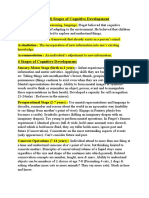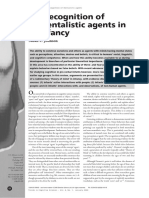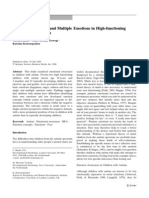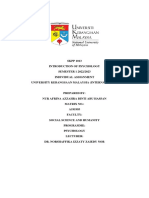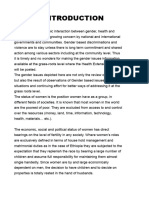Slaughter 2015
Slaughter 2015
Uploaded by
Makanudo.Copyright:
Available Formats
Slaughter 2015
Slaughter 2015
Uploaded by
Makanudo.Original Title
Copyright
Available Formats
Share this document
Did you find this document useful?
Is this content inappropriate?
Copyright:
Available Formats
Slaughter 2015
Slaughter 2015
Uploaded by
Makanudo.Copyright:
Available Formats
bs_bs_banner
INVITED CONTRIBUTION
Theory of Mind in Infants and Young Children: A Review
Virginia Slaughter
School of Psychology, The University of Queensland
Theory of mind, or mindreading, refers to our uniquely human capacity to infer what is in other people’s minds. Recent research suggests that
“implicit” elements of this ability can be seen as early as the second year of life, in infants’ spontaneous helping, communicative, and eye-gaze
behaviours. More “explicit” verbally mediated mindreading skills emerge in the preschool period, and these are positively linked to social
competence. Research with typically developing children as well as those with autism spectrum disorders suggests that exposure to conver-
sation about mental states promotes theory of mind development.
Key words: childhood; infancy; mindreading; review; theory of mind; review.
Social cognition in humans is uniquely complex. Unlike other items, yet the infants consistently ignored these distractors
mammals that respond primarily to each other’s external while pointing at or retrieving the marker for the adult
behaviours, we look deeper into each other’s minds in order to (Liszkowski, Carpenter, Striano, & Tomasello, 2006). This
understand one another. For instance, if we meet an acquaint- showed that 1-year-olds could work out the specific item that
ance whose father has recently died, we recognise that lagging the adult had in mind. In another experiment, 18-month-old
behind the conversation and “missing” the jokes are uninten- infants watched two adults playing with two toys. The toys were
tional behavioural consequences of her underlying sadness. put on a shelf and one of the adults left the room. The remaining
Throughout our everyday social interactions, we keep track— adult then brought out a new toy, played with it and then put it
consciously and unconsciously—of what other people feel, on the shelf as well. The first adult returned to the room and
want, and believe. This is referred to as mindreading, or using pointed towards the three toys on the shelf, saying “Oh look!
our theory of mind. It is a fundamental skill that helps us to Give it to me please!” In response, the infants retrieved the new
understand and get along with other people. toy—the one that particular adult had not yet played with. This
shows that the infants interpreted the adult’s pointing in terms
of what she thought was new and interesting (Moll &
Theory of Mind in Infancy
Tomasello, 2007).
Up until the late 1990s, most psychologists believed that chil- Another “implicit” aspect of mindreading is anticipating
dren became capable of mindreading between the ages of 3–5 someone’s intentions and their resulting behaviour. For
years, because that is when the vast majority of typically devel- instance, if you know your friend likes tomato sauce on his hot
oping children begin to pass tests assessing their ability to iden- chips, then as you sit down to eat, you are likely to shift your
tify someone’s mental state (Gopnik & Slaughter, 1991; eyes to the sauce bottle, anticipating his mental state as well as
Wellman, Cross, & Watson, 2001). Whether or not infants and his next move. Recent eye-tracking research shows that
toddlers also have a theory of mind was largely a theoretical 25-month-olds anticipate in this way, and furthermore, they
debate. But recent research suggests that infants and toddlers can anticipate a person’s next move even if that person is
possess “implicit” mindreading capacities. Although they cannot actually mistaken. In the eye-tracking study, toddlers watched a
explicitly declare what someone else wants or knows, very video in which an actor placed his toy in a box. When the actor
young children’s spontaneous helping and pointing, and their was not looking, the toy was moved to a different box. Upon the
eye-gaze patterns, reveal that they have some insight into other actor’s return, the toddlers anticipated his next move and
people’s minds. looked immediately to the first box, where the actor still
For instance, in one experiment, 12- to 18-month-old infants thought his toy was located (Southgate, Senju, & Csibra, 2007).
watched an adult write on a piece of paper with a marker. The This experiment shows unmistakable mindreading because the
marker dropped off the table, unseen by the adult, who began to toddlers anticipated the actor’s behaviour based on his false
search randomly for it. Already on the floor were some other belief, rather than on the physical location of the toy. A study
using precisely the same set up showed that 6- to 8-year-old
children with an autism spectrum disorder (ASD) failed to
Correspondence: Virginia Slaughter, School of Psychology, The University
of Queensland, Brisbane, QLD 4070, Australia. Fax: 07 3365 4466; email:
anticipate the actor’s next move; they did not reliably look to
vps@psy.uq.edu.au the box where the actor thought the toy was (Senju et al.,
2010). The same pattern has been observed in adults with ASD
Accepted for publication 13 August 2014
(Schneider, Slaughter, Bayliss, & Dux, 2013; Senju, Southgate,
doi:10.1111/ap.12080 White, & Frith, 2009). These findings indicate that implicit,
Australian Psychologist 50 (2015) 169–172 169
© 2015 The Australian Psychological Society
Theory of mind in infancy and childhood V Slaughter
Table 1 Six Tests That Make Up the Theory of Mind Scale. Research Shows That Australian, American and European Children Acquire These Concepts
Sequentially from Diverse Desires to Sarcasm (from Peterson et al., 2012)
Test Theory of mind concept assessed Proportion of 3- to 7-year-old
children who pass (%)
Diverse desires Different people may like and want different things. 92
Diverse beliefs Different people can hold different beliefs about the same thing. 87
Knowledge access People who see something also know about it; if they do not see, then they do not know. 85
False belief People do things based on what they think, even if they are mistaken. 56
Hidden emotion People can deliberately conceal emotions by facial expression management. 33
Sarcasm In order to be humorous, people sometimes say the opposite to what they really mean. 23
nonverbal mindreading is disrupted in individuals with ASD, emerges. For instance, in the same preschool class, one child
along with, and perhaps contributing to, the more explicit social may pass only the diverse desires task while another passes all
and communicative problems characteristic of this group. tasks up to hidden emotion. These individual differences have
been linked to some specific consequences for children’s every-
day social life. Although the effects are typically small, children
Mindreading in Young Children who perform relatively well on theory of mind tests also tend to
Soon after children begin to use language, they also begin to talk have relatively sophisticated social skills and effective social
about what is in their own and other people’s minds. By the age relationships in their daily lives.
of 4 years, up to 10% of typical children’s utterances make For instance, studies have shown that mindreading is related
reference to mental states using terms like want, think, know, to social competence in 3- to 8-year-old children. That is, those
pretend, and dream (Furrow, Moore, Davidge, & Chiasson, 1992; children who are good at working out what others feel, want,
Shatz, Wellman, & Silber, 1983). Perhaps surprisingly, among and think are nominated by their teachers and/or peers as being
verbally able children with ASD, the spontaneous production of most popular (Slaughter, Imuta, Peterson, & Henry, under
mental state terms is about equivalent to that of typical peers review) and socially mature (Peterson, Slaughter, & Paynter,
(Bang, Burns, & Nadig, 2013). Children’s capacity to talk about 2007). It is important to note that these findings are correla-
mental life is the basis of a wide variety of explicit, verbal tests tional, so we do not know if acquiring a theory of mind early
of mindreading. The standard paradigm involves describing a causes children to be socially competent and popular, or if those
social scenario, sometimes using cartoons or puppets, and then qualities put them in the best position to develop their
asking test questions about what the protagonists feel, want, or mindreading skills.
know, or what they will do next. A subset of these tests has Other studies indicate that 3- to 8-year-old children who
recently been made into a developmental scale. Research using perform well on theory of mind tests are skilled communicators,
the Theory of Mind Scale has revealed that Australian, North being particularly good conversationalists (de Rosnay, Fink,
American, and European 3- to 8-year-olds gradually master Begeer, Slaughter, & Peterson, 2013), adept at coming up with
different mindreading concepts in a reliable sequence, as out- arguments to persuade someone to do something (Slaughter,
lined in Table 1 (Peterson, Wellman, & Liu, 2005; Peterson, Peterson, & Moore, 2013), and convincing liars (Talwar & Lee,
Wellman, & Slaughter, 2012). This developmental pattern 2008). This third point highlights that mindreading enables
differs slightly among children in China and Iran, who reliably children to participate effectively in a wide range of social inter-
pass the knowledge access task before the diverse beliefs task actions, including potentially negative ones. Acquiring a theory
(Shahaeian, Peterson, Slaughter, & Wellman, 2011). These of mind does not necessarily make for a well-adjusted child;
cross-cultural differences in mindreading development may be indeed, more than one study has revealed that playground
related to Western versus non-Western families’ socialisation bullies, who are often somewhat popular as well as being feared
practices. In Australia, children with ASD tend to pass for their manipulative and aggressive interpersonal tactics, gen-
mindreading tasks at a later age and also in a slightly different erally do well on theory of mind tests (Gasser & Keller, 2009).
sequence from their typically developing peers, by mastering Mindreading helps children to understand their social world,
hidden emotion before false belief (Peterson et al., 2012). This but it appears that individual children’s temperament and life
finding reinforces the long-held conclusion that false belief is a experiences, among other things, determine how they use that
particularly difficult concept for people with an ASD. understanding.
Individual Differences in Theory of
Individual Differences in Mind—Where Do They Come from?
Mindreading—Implications for
Children’s Social Lives Although it is human nature to look past external behaviour
and into each other’s minds, the few genetic studies on theory
Within the reliable developmental sequence outlined in Table 1, of mind development to date suggest that nurture is a more
children vary in the ages at which their mindreading skill important determinant of individual differences. For instance, a
170 Australian Psychologist 50 (2015) 169–172
© 2015 The Australian Psychological Society
V Slaughter Theory of mind in infancy and childhood
behaviour genetic study comparing 1,116 monozygotic and and children’s theory of mind. Journal of Child Language, 32(3),
dizygotic 5-year-old twin pairs revealed that the majority of 673–686. doi:10.1017/S0305000905006963
individual variation in the children’s mindreading was attribut- Bang, J., Burns, J., & Nadig, A. (2013). Brief report: Conveying subjective
able to environment rather than to genes (Hughes et al., 2005). experience in conversation: Production of mental state terms and
personal narratives in individuals with high functioning autism. Journal
This finding contrasted with an earlier, smaller scale study of
of Autism and Developmental Disorders, 43(7), 1732–1740.
3-year-old twins, which revealed significant genetic influences
doi:10.1007/S10803-012-1716-4
on mindreading (Hughes & Cutting, 1999). More research is Dunn, J., & Brophy, M. (2005). Communication, relationships, and
necessary to reconcile these findings; however, one possibility is individual differences in children’s understanding of the mind. In J. W.
that genes play a role in early theory of mind development, but Astington & J. A. Baird (Eds.), Why language matters for theory of
by the age of 5 years, children’s mindreading is shaped primarily mind (pp. 50–69). New York, NY: Oxford University Press.
by their personal experiences. Dunn, J., Brown, J., Slomkowski, C., Tesla, C., & Youngblade, L. (1991).
One environmental variable that is crucial for theory of mind Young children’s understanding of other peoples feelings and
development is the regular exposure to language and conver- beliefs—individual differences and their antecedents. Child
sations about mental states (Dunn & Brophy, 2005). This may Development, 62(6), 1352–1366. doi:10.1111/J.1467-8624.1991
.Tb01610.X
explain the finding that preschool-aged children with one or
Furrow, D., Moore, C., Davidge, J., & Chiasson, L. (1992). Mental terms in
more siblings at home have an advantage in mindreading rela-
mothers’ and children’s speech—similarities and relationships.
tive to only children (McAlister & Peterson, 2006; Perner, Journal of Child Language, 19(3), 617–631. doi:10.1017/S0305000900
Ruffman, & Leekam, 1994). The hypothesis is that siblings are a 011594
constant source for learning about others’ mental perspectives. Gasser, L., & Keller, M. (2009). Are the competent the morally good?
In the daily course of teasing, instructing, comforting, disagree- Perspective taking and moral motivation of children involved in
ing, playing tricks, and arguing, brothers and sisters provide bullying. Social Development (Oxford, England), 18(4), 798–816.
exposure to others’ mental states. For children with ASD, the doi:10.1111/J.1467-9507.2008.00516.X
presence of siblings is less straightforward: A recent study indi- Gopnik, A., & Slaughter, V. (1991). Young children’s understanding of
cated that the presence of one or more older, but not younger changes in their mental states. Child Development, 62(1), 98–110.
doi:10.1111/J.1467-8624.1991.Tb01517.X
siblings, was associated with ASD-diagnosed children perform-
Guajardo, N. R., & Watson, A. C. (2002). Narrative discourse and theory of
ing relatively poor on mindreading tests (O’Brien, Slaughter, &
mind development. The Journal of Genetic Psychology, 163(3),
Peterson, 2011). This finding requires further investigation, but 305–325. doi:10.1080/00221320209598686
one interpretation is that older brothers and sisters may well Hughes, C., & Cutting, A. L. (1999). Nature, nurture, and individual
meaningly “protect” their younger sibling with ASD by refrain- differences in early understanding of mind. Psychological Science,
ing from conflictual interactions such as arguing or teasing, 10(5), 429–432. doi:10.1111/1467-9280.00181
which are actually valuable for acquiring a theory of mind. Hughes, C., Jaffee, S. R., Happe, F., Taylor, A., Caspi, A., & Moffitt, T. E.
The most well-documented environmental influence on chil- (2005). Origins of individual differences in theory of mind: From nature
dren’s mindreading is their parents’ propensity to talk about the to nurture? Child Development, 76(2), 356–370. doi:10.1111/J.1467
mind. Observational and experimental studies indicate that the -8624.2005.00850_A.X
Liszkowski, U., Carpenter, M., Striano, T., & Tomasello, M. (2006). 12- and
more frequently parents discuss and explain what they and
18-month-olds point to provide information for others. Journal of
others feel, want, and think, the better their children under-
Cognition and Development: Official Journal of the Cognitive
stand those concepts. This has been shown in disciplinary Development Society, 7(2), 173–187. doi:10.1207/S15327647
encounters (Ruffman, Perner, & Parkin, 1999; Shahaeian, jcd0702_2
Nielsen, Peterson, & Slaughter, 2014), mutual reminiscences McAlister, A., & Peterson, C. C. (2006). Mental playmates: Siblings,
(Taumoepeau & Reese, 2013), and book-reading (Adrian, executive functioning and theory of mind. The British Journal of
Clemente, Villanueva, & Rieffe, 2005; Slaughter, Peterson, & Developmental Psychology, 24, 733–751. doi:10.1348/026151005
MacKintosh, 2007) as well as in everyday family conversation x70094
(Dunn, Brown, Slomkowski, Tesla, & Youngblade, 1991). It is Moll, H., & Tomasello, M. (2007). How 14- and 18-month-olds know what
important to note that the positive link between children’s others have experienced. Developmental Psychology, 43(2), 309–317.
doi:10.1037/0012-1649.43.2.309
theory of mind and parents’ talk about mental states extends to
O’Brien, K., Slaughter, V., & Peterson, C. C. (2011). Sibling influences on
children with ASD (Slaughter et al., 2007). While not yet trans-
theory of mind development for children with ASD. Journal of Child
lated into formal interventions, training studies have shown Psychology and Psychiatry, and Allied Disciplines, 52(6), 713–719.
that exposure to such talk boosts mindreading skill in typically doi:10.1111/j.1469-7610.2011.02389.x
developing children (Guajardo & Watson, 2002). Therefore, Perner, J., Ruffman, T., & Leekam, S. R. (1994). Theory of mind is
parents should be encouraged to take the time to discuss feelings contagious: You catch it from your sibs. Child Development, 65(4),
and thoughts with their young children; not only will it make 1228–1238. doi:10.1111/j.1467-8624.1994.tb00814.x
for engaging conversation, but it is likely to benefit their chil- Peterson, C. C., Slaughter, V. P., & Paynter, J. (2007). Social maturity and
dren’s theory of mind. theory of mind in typically developing children and those on the
autism spectrum. Journal of Child Psychology and Psychiatry, and
Allied Disciplines, 48(12), 1243–1250. doi:10.1111/j.1469-7610.2007
References .01810.x
Peterson, C. C., Wellman, H. M., & Liu, D. (2005). Steps in theory-of-mind
Adrian, J. E., Clemente, R. A., Villanueva, L., & Rieffe, C. (2005). development for children with deafness or autism. Child Development,
Parent–child picture-book reading, mothers’ mental state language 76(2), 502–517. doi:10.1111/J.1467-8624.2005.00859.X
Australian Psychologist 50 (2015) 169–172 171
© 2015 The Australian Psychological Society
Theory of mind in infancy and childhood V Slaughter
Peterson, C. C., Wellman, H. M., & Slaughter, V. (2012). The mind behind Shahaeian, A., Peterson, C. C., Slaughter, V., & Wellman, H. M. (2011).
the message: Advancing theory-of-mind scales for typically developing Culture and the sequence of steps in theory of mind development.
children, and those with deafness, autism, or Asperger syndrome. Developmental Psychology, 47(5), 1239–1247. doi:10.1037/a0023899
Child Development, 83(2), 469–485. doi:10.1111/j.1467-8624.2011 Shatz, M., Wellman, H. M., & Silber, S. (1983). The acquisition of mental
.01728.x verbs: A systematic investigation of the first reference to mental state.
de Rosnay, M., Fink, E., Begeer, S., Slaughter, V., & Peterson, C. (2013). Cognition, 14(3), 301–321. doi:10.1016/0010-0277(83)90008-2
Talking theory of mind talk: Young school-aged children’s everyday Slaughter, V., Imuta, K., Peterson, C., & Henry, J. D. (under review).
conversation and understanding of mind and emotion. Journal of Child Meta-analysis of theory of mind and peer popularity in the preschool
Language, 41, 1179–1193. doi:10.1017/S0305000913000433 and early school years.
Ruffman, T., Perner, J., & Parkin, L. (1999). How parenting style affects Slaughter, V., Peterson, C. C., & MacKintosh, E. (2007). Mind what mother
false belief understanding. Social Development (Oxford, England), 8(3), says: Narrative input and theory of mind in typical children and those
395–411. doi:10.1111/1467-9507.00103 on the autism spectrum. Child Development, 78(3), 839–858.
Schneider, D., Slaughter, V. P., Bayliss, A. P., & Dux, P. E. (2013). A doi:10.1111/j.1467-8624.2007.01036.x
temporally sustained implicit theory of mind deficit in autism spectrum Slaughter, V., Peterson, C. C., & Moore, C. (2013). I can talk you into it:
disorders. Cognition, 129(2), 410–417. doi:10.1016/J.Cognition.2013 Theory of mind and persuasion behavior in young children.
.08.004 Developmental Psychology, 49(2), 227–231. doi:10.1037/A0028280
Senju, A., Southgate, V., Miura, Y., Matsui, T., Hasegawa, T., Tojo, Y., & Southgate, V., Senju, A., & Csibra, G. (2007). Action anticipation through
Csibra, G. (2010). Absence of spontaneous action anticipation by false attribution of false belief by 2-year-olds. Psychological Science, 18(7),
belief attribution in children with autism spectrum disorder. 587–592. doi:10.1111/J.1467-9280.2007.01944.X
Development and Psychopathology, 22(2), 353–360. doi:10.1017/ Talwar, V., & Lee, K. (2008). Social and cognitive correlates of children’s
S0954579410000106 lying behavior. Child Development, 79(4), 866–881. doi:10.1111/
Senju, A., Southgate, V., White, S., & Frith, U. (2009). Mindblind eyes: An j.1467-8624.2008.01164.x
absence of spontaneous theory of mind in Asperger syndrome. Taumoepeau, M., & Reese, E. (2013). Maternal reminiscing, elaborative
Science, 325(5942), 883–885. doi:10.1126/Science.1176170 talk, and children’s theory of mind: An intervention study. First
Shahaeian, A., Nielsen, M., Peterson, C., & Slaughter, V. (2014). Iranian Language, 33(4), 388–410. doi:10.1177/0142723713493347
mothers’ disciplinary strategies and theory of mind in children: A Wellman, H. M., Cross, D., & Watson, J. (2001). Meta-analysis of
focus on belief understanding. Journal of Cross-Cultural Psychology, theory-of-mind development: The truth about false belief. Child
45, 1110–1123. doi:10.1177/0022022114534772 Development, 72(3), 655–684. doi:10.1111/1467-8624.00304
172 Australian Psychologist 50 (2015) 169–172
© 2015 The Australian Psychological Society
You might also like
- Grade 8 - 2024 Term 1 Week 1-3 WORKSHEETSDocument11 pagesGrade 8 - 2024 Term 1 Week 1-3 WORKSHEETSJacqueline LeshageNo ratings yet
- Some Antecedents and Consequences of Social-Comparison JealousyDocument13 pagesSome Antecedents and Consequences of Social-Comparison JealousyMakanudo.No ratings yet
- Citizenship Grade 7 TextbookDocument147 pagesCitizenship Grade 7 Textbooklijyonas84% (19)
- Baron-Cohen Leslie & Frith 1985Document10 pagesBaron-Cohen Leslie & Frith 1985Ciera CorcaNo ratings yet
- The Sensory-Sensitive Child: Practical Solutions for Out-of-Bounds BehaviorFrom EverandThe Sensory-Sensitive Child: Practical Solutions for Out-of-Bounds BehaviorRating: 4.5 out of 5 stars4.5/5 (6)
- Slaughter-V-2015-Theory-Of-Mind-In-Infants-And-Young-Children-A-Review-Australian-Psychologist-503-169172 EsDocument10 pagesSlaughter-V-2015-Theory-Of-Mind-In-Infants-And-Young-Children-A-Review-Australian-Psychologist-503-169172 EsDalia Angelica Loaiza MarriagaNo ratings yet
- The Psychologist in The Baby: Ross A. ThompsonDocument8 pagesThe Psychologist in The Baby: Ross A. ThompsonkatnavNo ratings yet
- Theory of MindDocument2 pagesTheory of MindEmanuela NikolovaNo ratings yet
- 11Document9 pages11Eka SaputraNo ratings yet
- Dissociation SDocument15 pagesDissociation SgelouhNo ratings yet
- Piaget's (1896-1990) Stages of Cognitive DevelopmentDocument5 pagesPiaget's (1896-1990) Stages of Cognitive Development31316969No ratings yet
- local (17)Document6 pageslocal (17)timothywcleungNo ratings yet
- Early Intervention in Autism: Joint Attention and Symbolic PlayDocument31 pagesEarly Intervention in Autism: Joint Attention and Symbolic PlayEleni KeniniNo ratings yet
- Autism 4Document23 pagesAutism 4marcelolimaguerraNo ratings yet
- Cognitive Development - StatPearls - NCBI BookshelfDocument5 pagesCognitive Development - StatPearls - NCBI Bookshelf2156010222No ratings yet
- 13 - Mentalistic Agents in InfancyDocument7 pages13 - Mentalistic Agents in InfancyJúlia FerrazNo ratings yet
- Empathic Responsiveness of Children andDocument10 pagesEmpathic Responsiveness of Children andKaren VerkerkNo ratings yet
- Theory of Mind - Edited 1Document7 pagesTheory of Mind - Edited 1muriungiNo ratings yet
- Assessment 2 Psych NotesDocument13 pagesAssessment 2 Psych Notesdohakhadija05No ratings yet
- Early Identi®Cation of Autism by The Checklist For Autism in Toddlers (Chat)Document5 pagesEarly Identi®Cation of Autism by The Checklist For Autism in Toddlers (Chat)sulastri lastriNo ratings yet
- 629 FullDocument13 pages629 FullBobita BobiNo ratings yet
- Myersexppsych7e Im Module 08Document38 pagesMyersexppsych7e Im Module 08PratibhaNo ratings yet
- Cognitive DevelopmentDocument4 pagesCognitive DevelopmentVIRGINA PUTRINo ratings yet
- Developmental Changes in Young Children's Knowledge About The MindDocument27 pagesDevelopmental Changes in Young Children's Knowledge About The MindSpica RegulusNo ratings yet
- Sodian 1992Document16 pagesSodian 1992LORENA MONSERRAT MANCERA - HERNANDEZNo ratings yet
- Chapter 1 - Introduction To Child DevelopmentDocument20 pagesChapter 1 - Introduction To Child DevelopmentDSP SNo ratings yet
- Emotional Development in Children With Developmental Disabilities PDFDocument27 pagesEmotional Development in Children With Developmental Disabilities PDFL100% (1)
- Psych NotesDocument5 pagesPsych NotesRishona D' SouzaNo ratings yet
- How Children DevelopDocument78 pagesHow Children Developelizabethdeckert96No ratings yet
- Theory of Mind in Young People With Down's Syndrome: Francisco Javier Molina Cobos and M. Carmen Amador CastroDocument23 pagesTheory of Mind in Young People With Down's Syndrome: Francisco Javier Molina Cobos and M. Carmen Amador CastroCatalina CasellaNo ratings yet
- Awareness of Single and Multiple Emotions in High-Functioning Children With AutismDocument12 pagesAwareness of Single and Multiple Emotions in High-Functioning Children With AutismDiana ChanNo ratings yet
- 14Repacholi Meltzoff Et Al Infant Emotion EF 0Document12 pages14Repacholi Meltzoff Et Al Infant Emotion EF 0AlexandraNo ratings yet
- Child Psychology Research PaperDocument7 pagesChild Psychology Research PaperJamal DeNo ratings yet
- SKPP 1013 UkmDocument12 pagesSKPP 1013 UkmAfrina LanlanNo ratings yet
- Theory of Mind and Self-Consciousness: What Is It Like To Be Autistic?Document22 pagesTheory of Mind and Self-Consciousness: What Is It Like To Be Autistic?kiropankyNo ratings yet
- Nihms 1713741Document23 pagesNihms 1713741Man Lai LamNo ratings yet
- Esp G7Document16 pagesEsp G7Arlyn TuballasNo ratings yet
- Gustavo Albuquerque Dan Brady 7 March 2016: Developmental Psychology Tutorial EssayDocument4 pagesGustavo Albuquerque Dan Brady 7 March 2016: Developmental Psychology Tutorial EssayGustavo PatriotaNo ratings yet
- ResearchPaperFinalDraft_SamuelFerrellDocument11 pagesResearchPaperFinalDraft_SamuelFerrellsamuelferrell08No ratings yet
- Provided For Non-Commercial Research and Educational Use Only. Not For Reproduction, Distribution or Commercial UseDocument10 pagesProvided For Non-Commercial Research and Educational Use Only. Not For Reproduction, Distribution or Commercial Usedodoltala2003No ratings yet
- Prelock - Innovations in Theory of Mind Assessment & Interve PDFDocument95 pagesPrelock - Innovations in Theory of Mind Assessment & Interve PDFMuhammad Bilal ArshadNo ratings yet
- Frontal Lobe Contributions To Theory of Mind: Valerie E. StoneDocument17 pagesFrontal Lobe Contributions To Theory of Mind: Valerie E. StoneEmmanuelLeidiNo ratings yet
- Christian Colleges of Southeast AsiaDocument20 pagesChristian Colleges of Southeast AsiaCamilla Limbaga MaulaNo ratings yet
- Psychosocial Devt in Early Childhood - Cabug-Os, DG DEVPSYCHDocument57 pagesPsychosocial Devt in Early Childhood - Cabug-Os, DG DEVPSYCHdgcabugosNo ratings yet
- A. Thomas, S. Chess and H.G. Birch: The Origin of PersonalityDocument7 pagesA. Thomas, S. Chess and H.G. Birch: The Origin of PersonalityGil GonzálezNo ratings yet
- 10 Myths About The MindDocument21 pages10 Myths About The MindLevant HeartlandNo ratings yet
- Unit 9 Checks For Understanding Answers Fall 2013Document6 pagesUnit 9 Checks For Understanding Answers Fall 2013api-261267976No ratings yet
- Autism Current Issues 33 by Mike ConnorDocument12 pagesAutism Current Issues 33 by Mike Connorannette_mcdonald_2No ratings yet
- Autism Paper ThesisDocument7 pagesAutism Paper ThesisPaySomeoneToDoMyPaperCanada100% (1)
- Trevarthen 2003 CultureDocument15 pagesTrevarthen 2003 CultureMaria Sílvia CintraNo ratings yet
- Research Methods in Developmental PsychologyDocument19 pagesResearch Methods in Developmental PsychologyCABAGSANG KYLA T.No ratings yet
- Intramodal and Cross-Modal Matching of Emotional Expression in Young Children With Autism Spectrum DisordersDocument7 pagesIntramodal and Cross-Modal Matching of Emotional Expression in Young Children With Autism Spectrum Disordersbalkismelki31No ratings yet
- Have A One Track Mind: Lorna WingDocument4 pagesHave A One Track Mind: Lorna WingsophilauNo ratings yet
- Reading Unit 3Document4 pagesReading Unit 3GiangNo ratings yet
- Wellman Fang 2006Document7 pagesWellman Fang 2006godarkcourageNo ratings yet
- Annotated Bibliography - Research Project Enc - Katelyn SmithDocument6 pagesAnnotated Bibliography - Research Project Enc - Katelyn Smithapi-709160933No ratings yet
- Preschoolers and Toddlers Use Ownership To Predict Basic EmotionsDocument5 pagesPreschoolers and Toddlers Use Ownership To Predict Basic EmotionsIsabel Rubio100% (1)
- Week 2 Individual TASK - Table of Psychosocial Theories and TherapyDocument6 pagesWeek 2 Individual TASK - Table of Psychosocial Theories and TherapyAndrew Del RosarioNo ratings yet
- Eduu 575 Signature Assignment 1Document16 pagesEduu 575 Signature Assignment 1api-609548053No ratings yet
- Perkembangan Kanak-Kanak Dari Perspektif FisiologiDocument12 pagesPerkembangan Kanak-Kanak Dari Perspektif FisiologiNurrul JannahNo ratings yet
- Cognitive DevelopmentDocument5 pagesCognitive Developmentwaqasahmad00670No ratings yet
- Responses To The Negative Emotions of Others by Autistic, Mentally Retarded, and Normal ChildrenDocument13 pagesResponses To The Negative Emotions of Others by Autistic, Mentally Retarded, and Normal ChildrenBIANA-MARIA MACOVEINo ratings yet
- Cognitive DevelopmentDocument11 pagesCognitive DevelopmentJesus CollantesNo ratings yet
- Nsy 051Document9 pagesNsy 051Makanudo.No ratings yet
- Variation in Social Media Sensitivity Across People and ContextsDocument16 pagesVariation in Social Media Sensitivity Across People and ContextsMakanudo.No ratings yet
- Sebastian 2011Document9 pagesSebastian 2011Makanudo.No ratings yet
- Barlow 2014Document16 pagesBarlow 2014Makanudo.No ratings yet
- Vandeursen 2015Document10 pagesVandeursen 2015Makanudo.No ratings yet
- Primer: Autism Spectrum DisorderDocument23 pagesPrimer: Autism Spectrum DisorderMakanudo.No ratings yet
- Frison 2017Document7 pagesFrison 2017Makanudo.No ratings yet
- 1 s2.0 S0001691823002020 MainDocument9 pages1 s2.0 S0001691823002020 MainMakanudo.No ratings yet
- Meier - Reinecke - Postprint - 2020 - CMC, Social Media, and Mental Health - Conceptual and Empirical Meta-ReviewDocument73 pagesMeier - Reinecke - Postprint - 2020 - CMC, Social Media, and Mental Health - Conceptual and Empirical Meta-ReviewMakanudo.No ratings yet
- Schnauber-Stockmannetal 2018 ProcrastinationoutofhabitDocument31 pagesSchnauber-Stockmannetal 2018 ProcrastinationoutofhabitMakanudo.No ratings yet
- Meier 2021 Studying Problems Not Problematic Usage Do Mobile Checking Habits Increase Procrastination and Decrease WellDocument22 pagesMeier 2021 Studying Problems Not Problematic Usage Do Mobile Checking Habits Increase Procrastination and Decrease WellMakanudo.No ratings yet
- Taylor 1989Document7 pagesTaylor 1989Makanudo.No ratings yet
- Valkenburgetal2021SMUself esteemJOCDocument24 pagesValkenburgetal2021SMUself esteemJOCMakanudo.No ratings yet
- Trzesniewski 2006Document10 pagesTrzesniewski 2006Makanudo.No ratings yet
- Fpsyg 2019 02909Document21 pagesFpsyg 2019 02909Makanudo.No ratings yet
- Zmab 015Document19 pagesZmab 015Makanudo.No ratings yet
- The Affective Consequences of Social Comparison: Either Direction Has Its Ups and DownsDocument12 pagesThe Affective Consequences of Social Comparison: Either Direction Has Its Ups and DownsMakanudo.No ratings yet
- 1 s2.0 S0268401217310629 MainDocument12 pages1 s2.0 S0268401217310629 MainMakanudo.No ratings yet
- 1 s2.0 S1087079221000149 MainDocument11 pages1 s2.0 S1087079221000149 MainMakanudo.No ratings yet
- Chen 2019Document20 pagesChen 2019Makanudo.No ratings yet
- 2015 TheNewABCs - Neuroscience InformedCBTDocument16 pages2015 TheNewABCs - Neuroscience InformedCBTMakanudo.No ratings yet
- Associations Between Youth 'S Daily Social Media Use and Well-Being Are Mediated by Upward ComparisonsDocument13 pagesAssociations Between Youth 'S Daily Social Media Use and Well-Being Are Mediated by Upward ComparisonsMakanudo.No ratings yet
- Yang 2018Document15 pagesYang 2018Olivia RobertsonNo ratings yet
- Wills 1981Document27 pagesWills 1981Makanudo.No ratings yet
- Freytagetal2020PermanentlyOnline AlwaysStressedOut - Post PrintDocument53 pagesFreytagetal2020PermanentlyOnline AlwaysStressedOut - Post PrintMakanudo.No ratings yet
- Rhythms of Life - Circadian Disruption and Brain Disorders Across The LifespanDocument17 pagesRhythms of Life - Circadian Disruption and Brain Disorders Across The LifespanMakanudo.No ratings yet
- Pajkossy Dezso PaprikaIGTandanxietyDocument19 pagesPajkossy Dezso PaprikaIGTandanxietyMakanudo.No ratings yet
- By Gurpreet KalsiDocument15 pagesBy Gurpreet KalsiDaljit KalsiNo ratings yet
- DECE Assignments Jan - July 2023 (English)Document10 pagesDECE Assignments Jan - July 2023 (English)Charu SharmaNo ratings yet
- Participation, Facilitation, and Mediation. Children and Young People in Their Social Context (Introducción)Document85 pagesParticipation, Facilitation, and Mediation. Children and Young People in Their Social Context (Introducción)BENITO LUIS SOVERO SOTONo ratings yet
- Instant Download Psychiatric Interview of Children and Adolescents 1st Edition Claudio Cepeda PDF All ChapterDocument62 pagesInstant Download Psychiatric Interview of Children and Adolescents 1st Edition Claudio Cepeda PDF All Chaptereppikejian63100% (4)
- Teaching Math in The Primary Grades: Related PapersDocument4 pagesTeaching Math in The Primary Grades: Related PapersMae Rose JuliandaNo ratings yet
- Rpt2 Child LaborDocument1 pageRpt2 Child Labortranthamngoc2003No ratings yet
- Senior Nursery Curriculum Overview 1Document2 pagesSenior Nursery Curriculum Overview 1anitatkalayefaNo ratings yet
- Elimination of Violence Against Women GirlsDocument16 pagesElimination of Violence Against Women GirlsLoloNo ratings yet
- Background of The Study - CopyNewDocument6 pagesBackground of The Study - CopyNewJerico VillanuevaNo ratings yet
- Code of Sports EthicsDocument4 pagesCode of Sports EthicsRadu MiclausNo ratings yet
- Research Paper - Allison PorterDocument13 pagesResearch Paper - Allison Porterapi-609389611No ratings yet
- TCALLP 1 WEEK 2 Activity and AssignmentDocument4 pagesTCALLP 1 WEEK 2 Activity and AssignmentFatima LeyNo ratings yet
- The Impact of Friedrick Froebel On Education Through The AND CenturiesDocument12 pagesThe Impact of Friedrick Froebel On Education Through The AND CenturiesOlisa ChideraNo ratings yet
- 007 Sociology 145 Daily Class Notes UPSC Optional SociologDocument12 pages007 Sociology 145 Daily Class Notes UPSC Optional SociologBhargav RajNo ratings yet
- toys of peace-Q-A.docxDocument2 pagestoys of peace-Q-A.docxswapna4mainsNo ratings yet
- As AngolanasDocument137 pagesAs AngolanasEliane MaiaNo ratings yet
- (Ebook PDF) Human Development: A Life-Span View 7th Edition 2024 Scribd DownloadDocument41 pages(Ebook PDF) Human Development: A Life-Span View 7th Edition 2024 Scribd Downloadheljereljin100% (2)
- Đề thi thử theo form minh họa 2021Document92 pagesĐề thi thử theo form minh họa 2021Đỗ HảiNo ratings yet
- Children, International Protection: Evarist BaimuDocument10 pagesChildren, International Protection: Evarist BaimuSiddharth soniNo ratings yet
- Homework Is Good For Students DebateDocument7 pagesHomework Is Good For Students Debatecfzgiuilf100% (1)
- EOC DICAC Child Protection PolicyDocument14 pagesEOC DICAC Child Protection PolicyYonNo ratings yet
- Class 12Document10 pagesClass 12akshita singhNo ratings yet
- School Age ChildDocument5 pagesSchool Age ChildAndrea SandaloNo ratings yet
- 200 Would You Rather Questions For KidsDocument6 pages200 Would You Rather Questions For KidsZafar Habib ShaikhNo ratings yet
- Should Kids Be Social Media InfluencerDocument6 pagesShould Kids Be Social Media Influencershawaizshahid312100% (1)
- Parent Bulletin BoardDocument10 pagesParent Bulletin Boardapi-682600242No ratings yet
- Winnie Thesis 8-22-18Document105 pagesWinnie Thesis 8-22-18Winnie PodadorNo ratings yet
- BDP ChecklistDocument9 pagesBDP ChecklistBadidz Ong SucoNo ratings yet










